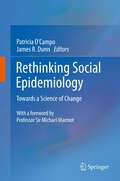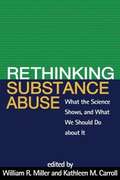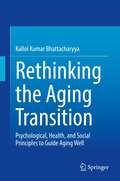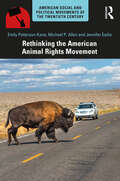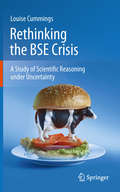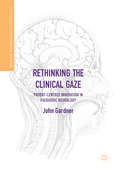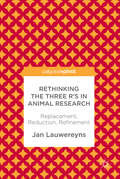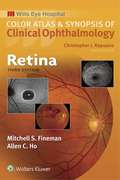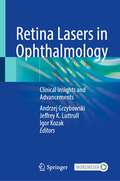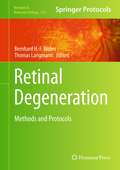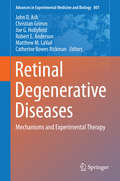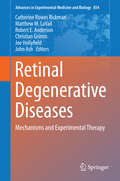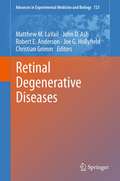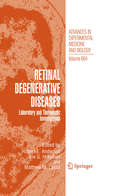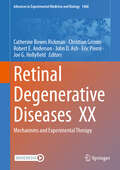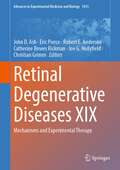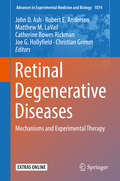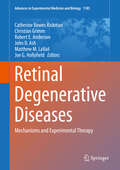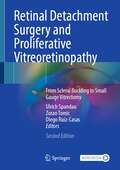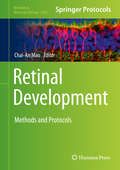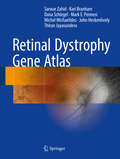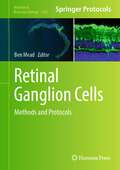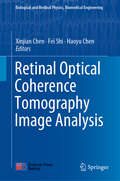- Table View
- List View
Rethinking Social Epidemiology
by James R. Dunn Patricia O’campoTo date, much of the empirical work in social epidemiology has demonstrated the existence of health inequalities along a number of axes of social differentiation. However, this research, in isolation, will not inform effective solutions to health inequalities. Rethinking Social Epidemiology provides an expanded vision of social epidemiology as a science of change, one that seeks to better address key questions related to both the causes of social inequalities in health (problem-focused research) as well as the implementation of interventions to alleviate conditions of marginalization and poverty (solution-focused research). This book is ideally suited for emerging and practicing social epidemiologists as well as graduate students and health professionals in related disciplines.
Rethinking Substance Abuse
by William MillerWhile knowledge on substance abuse and addictions is expanding rapidly, clinical practice still lags behind. This state-of-the-art book brings together leading experts to describe what treatment and prevention would look like if it were based on the best science available. The volume incorporates developmental, neurobiological, genetic, behavioral, and social-environmental perspectives. Tightly edited chapters summarize current thinking on the nature and causes of alcohol and other drug problems; discuss what works at the individual, family, and societal levels; and offer robust principles for developing more effective treatments and services.
Rethinking Thin: The New Science of Weight Loss—and the Myths and Realities of Dieting
by Gina KolataIn this eye-opening book, New York Times science writer Gina Kolata shows that our society's obsession with dieting and weight loss is less about keeping trim and staying healthy than about money, power, trends, and impossible ideals.Rethinking Thin is at once an account of the place of diets in American society and a provocative critique of the weight-loss industry. Kolata's account of four determined dieters' progress through a study comparing the Atkins diet to a conventional low-calorie one becomes a broad tale of science and society, of social mores and social sanctions, and of politics and power.Rethinking Thin asks whether words like willpower are really applicable when it comes to eating and body weight. It dramatizes what it feels like to spend a lifetime struggling with one's weight and fantasizing about finally, at long last, getting thin. It tells the little-known story of the science of obesity and the history of diets and dieting—scientific and social phenomena that made some people rich and thin and left others fat and miserable. And it offers commonsense answers to questions about weight, eating habits, and obesity—giving us a better understanding of the weight that is right for our bodies.
Rethinking Unequal Exchange
by Salimah ValianiRethinking Unequal Exchange traces the structural forces that have created the conditions for the increasing use, production, and circulation of temporary migrant nurses worldwide. Salimah Valiani explores the political economy of health care of three globally important countries in the importing and exporting of temporary migrant nurses: the Philippines, the world's largest supplier of temporary migrant nurses; the United States, the world's largest demander of internationally trained nurses; and Canada, which is both a supplier and a demander of internationally trained nurses. Using a world historical approach, Valiani demonstrates that though nursing and other caring labour is essential to human, social, and economic development, the exploitation of care workers is escalating. Valiani cogently shows how the global integration of nursing labour markets is deepening unequal exchange between the global North and the global South.
Rethinking the Aging Transition: Psychological, Health, and Social Principles to Guide Aging Well
by Kallol Kumar BhattacharyyaThe transitional phase from pre-older adult to older adult affects the wellbeing of the concerned person economically, physically, and psychologically. This book is a description of the aging transition and discusses various psychological, health, and social challenges faced by older adults globally. It also offers a comparative study on the lifestyles of older adults in India and the United States.Although there is no consensus yet on an all-encompassing theory of aging, this book centers on various theories related to aging processes in an effort to advance discussion on different aspects of aging. Various theoretical formulations, such as person-centered, Hinduism, biopsychosocial, and positive psychology, guided the author to address the topics covered in this volume.Aging and PhysiciansAging and RetirementAging, Caregiving, and COVID-19Aging and DiversityAging and LongevityAging, Disease Prevention, and TechnologyAging and SpiritualityThrough the chapters, the author builds an understanding of the fundamental relation of aging with various health and socioeconomic factors, and also emphasizes a person-centered, holistic approach that values personal autonomy, choice, comfort, dignity, and purposeful living to support aging well. Rethinking the Aging Transition: Psychological, Health, and Social Principles to Guide Aging Well has academic value from a multicultural perspective that would be of benefit to graduate and undergraduate students in gerontology and other disciplines that study aging and older adult populations. With the main aim of raising awareness, this book is an important resource for a diverse group of populations globally, including clinical and non-clinical caregivers, other health(care) professionals, and policy-makers.
Rethinking the American Animal Rights Movement (American Social and Political Movements of the 20th Century)
by Emily Patterson-Kane Michael P. Allen Jennifer EadieAlong with Civil Rights and Women’s liberation, Animal Rights became one of leading social moments of the twentieth century. This book critically reviews all principal contributions to the American animal rights debate by activists, campaigners, academics, and lawyers, while placing animal rights in context with other related and competing movements. Rethinking the American Animal Rights Movement examines the strategies employed within the movement to advance its goals, which ranged from public advocacy and legal reforms to civil disobedience, vigilantism, anarchism, and even "terrorism." It summarizes key theoretical and legal frameworks that inspired those strategies, as well as the ideological motivations of the movement. It highlights the irreconcilable tension between moral and legal rights verses "humane treatment of animals" as prescribed by advocates of animal welfarism. The book also looks back to the nineteenth century origins of the movement, examining its appeal to a sentimentalist conception of rights standing in marked contrast with twentieth century rights theory. After providing an extensive social history of the twentieth century movement, the book subsequently offers a diagnosis of why it stalled at the turn of millennium in its various efforts to advance the cause of nonhuman animals. This diagnosis emphasizes the often-contradictory goals and strategies adopted by the movement in its different phases and manifestations across three centuries. The book is unique in presenting students, activists, and scholars with a history and critical discussion of its accomplishments, failures, and ongoing complexities faced by the American animal rights movement.
Rethinking the BSE Crisis
by Louise CummingsIn 1986, the emergence of a novel brain disease in British cattle presented a unique challenge to scientists. How that challenge was addressed has been the subject of a public inquiry and numerous academic studies conducted to date. However, none of these investigations has sought to examine the reasoning of scientists during this critical period in the public health of the UK. Using concepts and techniques in informal logic, argumentation and fallacy theory, this study reconstructs and evaluates the reasoning of scientists in the ten-year period between 1986 and 1996. Specifically, a form of presumptive reasoning is described in which extensive use is made of arguments traditionally identified as informal fallacies. In the context of the adverse epistemic conditions that confronted scientists during the BSE epidemic, these arguments were anything but fallacious, serving instead to confer a number of epistemic gains upon scientific inquiry. This book argues for a closer integration of philosophy with public health science, an integration that is exemplified by the case of scientific reasoning during the BSE affair. It will therefore be of interest to advanced students, academics, researchers and professionals in the areas of public health science and epidemiology, as well as philosophical disciplines such as informal logic, argumentation and fallacy theory and epistemology.
Rethinking the Clinical Gaze
by John GardnerThis book draws on medical sociology and science and technology studies to develop a novel conceptual framework for understanding innovation processes, using the case study of deep brain stimulation in paediatric neurology. It addresses key questions, including: How are promising and potentially disruptive new health technologies integrated into busy resource-constrained clinical contexts? What activities are involved in establishing a new clinical service? How do social and cultural forces shape these services, and importantly, how are understandings of 'health' and 'illness' reconfigured in the process? The book explores how the ideals of patient-centred medicine influence innovation in the clinic, and it introduces the concept of patient-centred proto-platforms. It argues that patient-centred innovation can constitute an expansion of medical power, as the clinical gaze is directed not only towards the body but also towards the patient as a social being. This will be an innovative and insightful read for academics and advanced students, as well as health service researchers with an interest in technology adoption processes.
Rethinking the Three R's in Animal Research: Replacement, Reduction, Refinement
by Jan LauwereynsThis work challenges the current reliance on "The Three R's" or Replacement, Reduction and Refinement which direct most animal research in the behavioral sciences. The author argues that these principles that were developed in the 1950's to guide the use of animals in research studies are outdated. He suggests that the notions of refinement and reduction are often ill-defined and can be useful only in cases where replacement is impossible.
Retina (Color Atlas and Synopsis of Clinical Ophthalmology)
by Mitchell FinemanPublisher's Note: Products purchased from 3rd Party sellers are not guaranteed by the Publisher for quality, authenticity, or access to any online entitlements included with the product. Developed at Philadelphia’s world-renowned Wills Eye Hospital, the Color Atlas and Synopsis of Clinical Ophthalmology series covers the most clinically relevant aspects of ophthalmology in a highly visual, easy-to-use format. Vibrant, full-color photos and a consistent outline structure present a succinct, high-yield approach to the seven topics covered by this popular series: Cornea, Retina, Glaucoma, Oculoplastics, Neuro-Ophthalmology, Pediatrics, and Uveitis. This in-depth, focused approach makes each volume an excellent companion to the larger Wills Eye Manual as well as a practical stand-alone reference for students, residents, and practitioners in every area of ophthalmology.
Retina Lasers in Ophthalmology: Clinical Insights and Advancements
by Andrzej Grzybowski Igor Kozak Jeffrey K. LuttrullThis book discusses the new era of modern retinal laser therapy and its clinical applications. While the photocoagulation era universally presupposed the therapeutic necessity of laser-induced retinal damage, the modern retinal laser therapy is equally opposed to this idea. The evidence for this sea-change in the understanding of retinal laser is well presented within this book, and the conceptual and clinical consequences are discussed with particular emphasis on the emergence of retinal laser therapy as the first reasonable preventive and restorative intervention for the most important retinal disorders. Finally, the future of modern retinal laser therapy is highlighted with respect to coming technological advances, remaining challenges, and the place of retinal laser in the management of retinal disease. This book is an essential resource for all ophthalmic residents and clinicians seeking a clear and concise guide to modern retinal laser therapy in their everyday practice.
Retinal Degeneration
by Bernhard H.F. Weber Thomas LangmannOver the past decades, knowledge about the cellular and molecular basis underlying the visual process has remarkably increased. In Retinal Degeneration: Methods and Protocols, expert researchers in the field provide a guide of relevant and state-of-the-art methods for studying retinal homeostasis and disease. These include methods and techniques for addressing cell culture systems and animal models of disease, their generation, their phenotypic and molecular characterization as well as their use in therapeutic approaches to the retina. Written in the highly successful Methods in Molecular BiologyTM series format, chapters include introductions to their respective topics, lists of the necessary materials and reagents, step-by-step, readily reproducible laboratory protocols, and key tips on troubleshooting and avoiding known pitfalls. Authoritative and practical, Retinal Degeneration: Methods and Protocols aids scientists in continuing to study the cutting-edge techniques of retinal cell biology in health and disease.
Retinal Degenerative Diseases
by Matthew M. Lavail Joe G. Hollyfield Robert E. Anderson Christian Grimm John D. Ash Catherine Bowes RickmanThis book will contain the proceedings of the XV International Symposium on Retinal Degeneration (RD2012). A majority of those who will speak and present posters at the meeting will contribute to this volume. The blinding diseases of inherited retinal degenerations have no treatments, and age-related macular degeneration has no cures, despite the fact that it is an epidemic among the elderly, with 1 in 3-4 affected by the age of 70. The RD Symposium will focus on the exciting new developments aimed at understanding these diseases and providing therapies for them. Since most major scientists in the field of retinal degenerations attend the biennial RD Symposia, they are known by most as the "best" and "most important" meetings in the field. The volume will present representative state-of-the-art research in almost all areas of retinal degenerations, ranging from cytopathologic, physiologic, diagnostic and clinical aspects; animal models; mechanisms of cell death; candidate genes, cloning, mapping and other aspects of molecular genetics; and developing potential therapeutic measures such as gene therapy and neuroprotective agents for potential pharmaceutical therapy. While advances in these areas of retinal degenerations will be described, there will be many new topics that either were in their infancy or did not exist at the time of the last RD Symposium, RD2010. These include the role of inflammation and immunity, as well as other basic mechanisms, in age-related macular degeneration, several new aspects of gene therapy, and revolutionary new imaging and functional testing that will have a huge impact on the diagnosis and following the course of retinal degenerations, as well as to provide new quantitative endpoints for clinical trials. The retina is an approachable part of the central nervous system (CNS), and there is a major interest in neuroprotective and gene therapy for CNS diseases and neurodegenerations, in general. It should be noted that with successful and exciting initial clinical trials in neuroprotective and gene therapy, including the restoration of sight in blind children, the retinal degeneration therapies are leading the way towards new therapeutic measures for neurodegenerations of the CNS. Many of the successes recently reported in these areas of retinal degeneration sprang from collaborations established at previous RD Symposia, and many of those will be reported at the RD2010 meeting and included in the proposed volume. We anticipate the excitement of those working in the field and those afflicted with retinal degenerations will be reflected in the volume.
Retinal Degenerative Diseases
by Matthew M. Lavail Robert E. Anderson Christian Grimm John Ash Catherine Bowes Rickman Joe HollyfieldContains the proceedings of the XVI International Symposium on Retinal Degeneration (RD2014), to be held July 13-18, 2014 at the Asilomar Conference Center in Pacific Grove, California. A majority of those who will speak and present posters at the meeting will contribute to this volume. The Symposium addresses the blinding diseases of inherited retinal degenerations, which have no effective treatments and age-related macular degeneration, which has no cures, despite the fact that it is an epidemic among the elderly, with 1 in 3-4 affected by the age of 75. The RD2014 Symposium will focus on the exciting new developments aimed at understanding these diseases and providing therapies for them. The volume will present representative state-of-the-art research in almost all areas of retinal degenerations, ranging from cytopathologic, physiologic, diagnostic and clinical aspects; animal models; mechanisms of cell death; molecular genetics; and developing potential therapeutic measures such as gene therapy and neuroprotective agents for potential pharmaceutical therapy; and several sight restoration approaches, including optogenetics. While advances in these areas of retinal degenerations will be included, several new topics either were in their infancy or did not exist at the time of the last RD Symposium, RD2012. These include many new developments in sight restoration using optogenetics, retinal or RPE cell transplantation, stem cell approaches and visual prosthetic devices. In addition, major advances will be presented in other basic mechanisms in age-related macular degeneration, several new aspects of gene and antioxidant therapy and revolutionary new imaging and functional testing that will have a huge impact on the diagnosis and following the course of retinal degenerations, as well as to provide new quantitative endpoints for clinical trials. The retina is an approachable part of the central nervous system (CNS), and there is a major interest in neuroprotective and gene therapy for CNS diseases and neurodegenerations, in general. It should be noted that with successful and exciting initial clinical trials in neuroprotective and gene therapy, including the restoration of sight in blind children, the retinal degeneration therapies are leading the way towards new therapeutic measures for neurodegenerations of the CNS. Many of the successes recently reported in these areas of retinal degeneration sprang from collaborations established at previous RD Symposia, and many of those will be reported at the RD2014 meeting and included.
Retinal Degenerative Diseases
by Matthew M. Lavail Joe G. Hollyfield Robert E. Anderson Christian Grimm John AshThis book will contain the proceedings of the XIV International Symposium on Retinal Degeneration (RD2010), held July 13-17, 2010, in Mont-Tremblant, Quebec, Canada. The volume will present representative state-of-the-art research in almost all areas of retinal degenerations, ranging from cytopathologic, physiologic, diagnostic and clinical aspects; animal models; mechanisms of cell death; candidate genes, cloning, mapping and other aspects of molecular genetics; and developing potential therapeutic measures such as gene therapy and neuroprotective agents for potential pharmaceutical therapy.
Retinal Degenerative Diseases
by Matthew M. Lavail Joe G. Hollyfield Robert E. AndersonThis is the proceedings of the XIIIth International Symposium on Retinal Degenerations, which will be held in Emeishan, Sichuan, China on September 18 - 23, 2008. The themes will include "Molecular and genetic mechanisms in photoreceptor degeneration", "Age-related macular degeneration", "New diagnostic techniques for retinal degenerations". "Neuroprotection in the prevention of retinal degeneration", "Gene therapy and the correction of gene defects", as well as other emerging topics that may develop over the next few months.
Retinal Degenerative Diseases XX: Mechanisms and Experimental Therapy (Advances in Experimental Medicine and Biology #1468)
by Joe G. Hollyfield Robert E. Anderson Christian Grimm John D. Ash Catherine Bowes Rickman Eric PierceThis book contains the proceedings of the XVIII International Symposium on Retinal Degeneration (RD2018). A majority of those who spoke and presented posters at the meeting contributed to this volume. Most blinding [CG1] diseases of inherited retinal degenerations have no treatments, and age-related macular degeneration has no cures, despite the fact that it is an epidemic among the elderly, with 1 in 3-4 affected by the age of 70. The RD Symposium focused on the exciting new developments aimed at understanding these diseases and providing therapies for them. Since most major scientists in the field of retinal degenerations attend the biennial RD Symposia, they are known by most as the “best” and “most important” meetings in the field. The volume presents representative state-of-the-art research in almost all areas of retinal degenerations, ranging from cytopathologic, physiologic, diagnostic and clinical aspects; animal models; mechanisms of cell death; candidate genes, cloning, mapping and other aspects of molecular genetics; and developing potential therapeutic measures such as gene therapy and neuroprotective agents for potential pharmaceutical therapy. Significant advances in these areas of retinal degenerations have been made since the last RD Symposium, RD2021. These include the role of inflammation and immunity, as well as other basic mechanisms, in age-related macular degeneration, several new aspects of gene therapy, and revolutionary new imaging and functional testing that will have a huge impact on the diagnosis and following the course of retinal degenerations, as well as to provide new quantitative endpoints for clinical trials. The retina is an approachable part of the central nervous system (CNS), and there is a major interest in neuroprotective and gene therapy for CNS diseases and neurodegenerations, in general. It should be noted that with successful and exciting initial clinical trials in neuroprotective and gene therapy, including the restoration of sight in blind children, the retinal degeneration therapies are leading the way towards new therapeutic measures for neurodegenerations of the CNS. Many of the successes recently reported in these areas of retinal degeneration sprang from collaborations established at previous RD Symposia, and many of those were reported at the RD2023 meeting and included in the current volume. We anticipate the excitement of those working in the field and those afflicted with retinal degenerations is reflected in the volume.
Retinal Degenerative Diseases XIX: Mechanisms and Experimental Therapy (Advances in Experimental Medicine and Biology #1415)
by Joe G. Hollyfield Robert E. Anderson Christian Grimm John D. Ash Catherine Bowes Rickman Eric PierceThis book contains the proceedings of the XVIII International Symposium on Retinal Degeneration (RD2018). A majority of those who spoke and presented posters at the meeting contributed to this volume. The blinding diseases of inherited retinal degenerations have no treatments, and age-related macular degeneration has no cures, despite the fact that it is an epidemic among the elderly, with 1 in 3-4 affected by the age of 70. The RD Symposium focused on the exciting new developments aimed at understanding these diseases and providing therapies for them. Since most major scientists in the field of retinal degenerations attend the biennial RD Symposia, they are known by most as the “best” and “most important” meetings in the field.The volume presents representative state-of-the-art research in almost all areas of retinal degenerations, ranging from cytopathologic, physiologic, diagnostic and clinical aspects; animal models; mechanisms of cell death; candidate genes, cloning, mapping and other aspects of molecular genetics; and developing potential therapeutic measures such as gene therapy and neuroprotective agents for potential pharmaceutical therapy. While advances in these areas of retinal degenerations were described, there will be many new topics that either are in their infancy or did not exist at the time of the last RD Symposium. These include the role of inflammation and immunity, as well as other basic mechanisms, in age-related macular degeneration, several new aspects of gene therapy, and revolutionary new imaging and functional testing that will have a huge impact on the diagnosis and following the course of retinal degenerations, as well as to provide new quantitative endpoints for clinical trials. The retina is an approachable part of the central nervous system (CNS), and there is a major interest in neuroprotective and gene therapy for CNS diseases and neurodegenerations, in general. It should be noted that with successful and exciting initial clinical trials in neuroprotective and gene therapy, including the restoration of sight in blind children, the retinal degeneration therapies are leading the way towards new therapeutic measures for neurodegenerations of the CNS. Many of the successes recently reported in these areas of retinal degeneration sprang from collaborations established at previous RD Symposia, and many of those were reported at the RD2016 meeting and included in the current volume. We anticipate the excitement of those working in the field and those afflicted with retinal degenerations is reflected in the volume.
Retinal Degenerative Diseases: Laboratory And Therapeutic Investigations (Advances In Experimental Medicine And Biology #723)
by Joe G. Hollyfield Robert E. Anderson Christian Grimm John D. Ash Catherine Bowes Rickman Matthew M. LaVailThe blinding diseases of inherited retinal degenerations have no treatments, and age-related macular degeneration has no cures, despite the fact that it is an epidemic among the elderly, with 1 in 3-4 affected by the age of 70. The RD Symposium will focus on the exciting new developments aimed at understanding these diseases and providing therapies for them. Since most major scientists in the field of retinal degenerations attend the biennial RD Symposia, they are known by most as the “best” and “most important” meetings in the field. The volume will present representative state-of-the-art research in almost all areas of retinal degenerations, ranging from cytopathologic, physiologic, diagnostic and clinical aspects; animal models; mechanisms of cell death; candidate genes, cloning, mapping and other aspects of molecular genetics; and developing potential therapeutic measures such as gene therapy and neuroprotective agents for potential pharmaceutical therapy. While advances in these areas of retinal degenerations will be described, there will be many new topics that either were in their infancy or did not exist at the time of the last RD Symposium, RD2014. These include the role of inflammation and immunity, as well as other basic mechanisms, in age-related macular degeneration, several new aspects of gene therapy, and revolutionary new imaging and functional testing that will have a huge impact on the diagnosis and following the course of retinal degenerations, as well as to provide new quantitative endpoints for clinical trials. The retina is an approachable part of the central nervous system (CNS), and there is a major interest in neuroprotective and gene therapy for CNS diseases and neurodegenerations, in general. It should be noted that with successful and exciting initial clinical trials in neuroprotective and gene therapy, including the restoration of sight in blind children, the retinal degeneration therapies are leading the way towards new therapeutic measures for neurodegenerations of the CNS. Many of the successes recently reported in these areas of retinal degeneration sprang from collaborations established at previous RD Symposia, and many of those will be reported at the RD2018 meeting and included in the proposed volume. We anticipate the excitement of those working in the field and those afflicted with retinal degenerations will be reflected in the volume.
Retinal Degenerative Diseases: Mechanisms and Experimental Therapy (Advances in Experimental Medicine and Biology #1185)
by Joe G. Hollyfield Robert E. Anderson Christian Grimm John D. Ash Catherine Bowes Rickman Matthew M. LaVailThis book contains the proceedings of the XVIII International Symposium on Retinal Degeneration (RD2018). A majority of those who spoke and presented posters at the meeting contributed to this volume. The blinding diseases of inherited retinal degenerations have no treatments, and age-related macular degeneration has no cures, despite the fact that it is an epidemic among the elderly, with 1 in 3-4 affected by the age of 70. The RD Symposium focused on the exciting new developments aimed at understanding these diseases and providing therapies for them. Since most major scientists in the field of retinal degenerations attend the biennial RD Symposia, they are known by most as the “best” and “most important” meetings in the field. The volume presents representative state-of-the-art research in almost all areas of retinal degenerations, ranging from cytopathologic, physiologic, diagnostic and clinical aspects; animal models; mechanisms of cell death; candidate genes, cloning, mapping and other aspects of molecular genetics; and developing potential therapeutic measures such as gene therapy and neuroprotective agents for potential pharmaceutical therapy. While advances in these areas of retinal degenerations were described, there will be many new topics that either are in their infancy or did not exist at the time of the last RD Symposium, RD2016. These include the role of inflammation and immunity, as well as other basic mechanisms, in age-related macular degeneration, several new aspects of gene therapy, and revolutionary new imaging and functional testing that will have a huge impact on the diagnosis and following the course of retinal degenerations, as well as to provide new quantitative endpoints for clinical trials. The retina is an approachable part of the central nervous system (CNS), and there is a major interest in neuroprotective and gene therapy for CNS diseases and neurodegenerations, in general. It should be noted that with successful and exciting initial clinical trials in neuroprotective and gene therapy, including the restoration of sight in blind children, the retinal degeneration therapies are leading the way towards new therapeutic measures for neurodegenerations of the CNS. Many of the successes recently reported in these areas of retinal degeneration sprang from collaborations established at previous RD Symposia, and many of those were reported at the RD2016 meeting and included in the current volume. We anticipate the excitement of those working in the field and those afflicted with retinal degenerations is reflected in the volume.
Retinal Detachment Surgery and Proliferative Vitreoretinopathy: From Scleral Buckling to Small Gauge Vitrectomy
by Ulrich Spandau Zoran Tomic Diego Ruiz-CasasThis clinically oriented book provides a complete overview of retinal detachment and Proliferative vitreoretinopathy (PVR), a difficult surgical challenge faced by ophthalmologists. Small gauge vitrectomy offers new possibilities to tackle this difficult pathology however this surgical approach may differ from one retinal surgeon to the next. To reflect the various approaches to treating PVR, the book is divided up in three parts. In the first part the authors describe the complete variety of surgical techniques applied to retinal detachment. In the second section, the surgical approach for PVR detachment is demonstrated step-by-step. In the third part, a large variety of retinal surgeons from Europe discuss video case reports of PVR retinal detachment to give a complete overview of dealing with this complex retinal disorder. The book is practical, down to earth, the surgeries are explained in detail, illustrated with drawings, photographs and refers to a huge number of videos available via Dr. Spandau’s YouTube channel.
Retinal Development: Methods and Protocols (Methods in Molecular Biology #2092)
by Chai-An MaoThis volume details commonly used molecular and cellular techniques and specialized methodologies for studying retina neuronal subtypes and electrophysiology. Chapters describe techniques for anatomical studies of retinal ganglion cell morphology, gap-junction-mediated neuronal connection, multi-electrode array recording on mouse retinas, and paired recording to study the electrical coupling between photoreceptors. Written in the highly successful Methods in Molecular Biology series format, chapters include introductions to their respective topics, lists of the necessary materials and reagents, step-by-step, readily reproducible laboratory protocols, and tips on troubleshooting and avoiding known pitfalls. Authoritative and cutting-edge, Retinal Development: Methods and Protocols aims to provide readers with a set of practical experimental tools to study retinal development, regeneration, and function of mature retinal neurons. Many of the protocols and strategies described in one organism can be easily adapted to applications in different model systems.
Retinal Dystrophy Gene Atlas
by Sarwar Zahid Kari Branham Dana Schlegel Mark E. Pennesi Michel Michaelides John Heckenlively Thiran JayasunderaClassically, photo atlases of retinal dystrophies have been divided into sections that describe and depict a particular retinal finding or disease, after which a differential diagnosis of potential diseases or mutated genes is provided. However, given the rapid improvement in molecular diagnostics, and the exponential increase in our understanding of the phenotypes caused by each mutated gene, the paradigm has changed. Physicians are now more interested in the variable expressivity associated with mutations in each individual gene. Therefore, Retinal Dystrophy Gene Atlas catalogs the different phenotypes that have been reported with each mutated gene. Each section describes a gene and its known clinical phenotypes and features of disease, along with retinal photos of affected patients. Written by prominent retinal dystrophy specialists from the largest dystrophy centers worldwide, Retinal Dystrophy Gene Atlas contains more than 80 chapters, each of which describes the clinical and photographic manifestations of a specific gene. The chapters include stunning clinical color photographs of the retina, autofluorescence imaging, electrophysiologic findings, and cross-sectional imaging. Retinal Dystrophy Gene Atlas serves as a resource to aid genetic diagnosis in patients with retinal dystrophies.
Retinal Ganglion Cells: Methods and Protocols (Methods in Molecular Biology #2708)
by Ben MeadThis collection provides methods and techniques employed when culturing, manipulating, quantifying, and functionally assessing retinal ganglion cells (RGCs), vital for better understanding various ocular diseases and for developing novel therapies. The book features exhaustive and detailed protocols for the study of RGCs at both the in vitro and in vivo level, including the culture of rodent and human cells, and immunohistochemical, morphological, and functional assessments of various in vivo models of RGC death. Written for the highly successful Methods in Molecular Biology series, chapters include introductions to their respective topics, lists of the necessary materials and reagents, step-by-step and readily reproducible laboratory protocols, and tips on troubleshooting and avoiding known pitfalls. Authoritative and practical, Retinal Ganglion Cells: Methods and Protocols serves as an ideal guide to these important cellular features of the central nervous system and the many traumatic and degenerative blinding diseases that affect them.
Retinal Optical Coherence Tomography Image Analysis (Biological and Medical Physics, Biomedical Engineering)
by Xinjian Chen Fei Shi Haoyu ChenThis book introduces the latest optical coherence tomography (OCT) imaging and computerized automatic image analysis techniques, and their applications in the diagnosis and treatment of retinal diseases. Discussing the basic principles and the clinical applications of OCT imaging, OCT image preprocessing, as well as the automatic detection and quantitative analysis of retinal anatomy and pathology, it includes a wealth of clinical OCT images, and state-of-the-art research that applies novel image processing, pattern recognition and machine learning methods to real clinical data. It is a valuable resource for researchers in both medical image processing and ophthalmic imaging.
